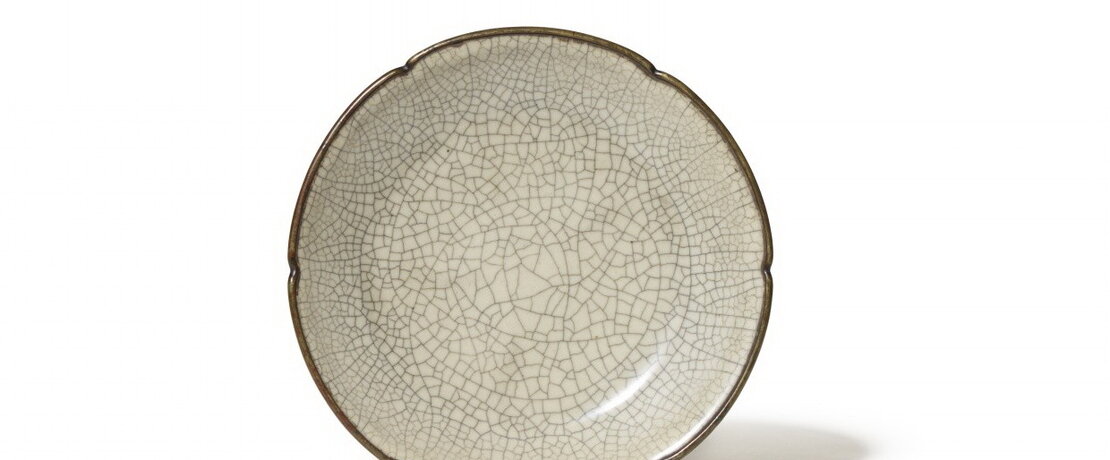Million Euro Plate

The saleroom gradually grew silent when the Ge-ware plate was called. The exceedingly rare plate measured just 14 cm in diameter, barely larger than the palm of a hand, and originated from the collection of Dr. Otto Hasse in Bremen (of Hachez-Schockolade fame). Bidding started at € 150,000, and alongside saleroom bidders, nine telephone bidders entered the arena to compete for the piece. The bids rose at intervals of € 20,000, €30,000, and €50,000, before finally reaching the €100,000 mark to surpass € 500,000 and end at a hammer price of € 1,125,000 (without VAT). The imperial ware will now be returning to China. It was the highest price for a work of art from Asia to be achieved at auction in Germany this year, and the highest price for a comparable piece in recent years. The remarkable Ge-ware plate was made in the Southern Song/Yuan era (1127 – 1368) and formed the highlight of an impressive German collection of 21 items of ceramics and other decorative arts. For centuries, the crackle glazed stoneware of the Song Dynasty (1127 – 1279) has been surrounded by an aura of mystery, and connoisseurs of the Yuan and Ming dynasties have praised its beauty and elegance in poetry and prose (lot 867, €200/250,000).
A further highlight of the auction was the large fire-gilt bronze figure of Buddha Shakyamuni which sold for € 312,000. The work was produced during the late Ming Dynasty in the 17th century and measured 50 cm in height. The bronze originated from a Rhenish private collection and was already auctioned once before at Lempertz in 1931 (lot 694, € 200/250,000).
A further top lot at this season's auction was a large imperial Cloisonné enamel alms dish with a four-character Qianlong mark of the period (1736 – 1795). The plate originated from a further Rhenish private collection of over 40 items in cloisonné enamel.
Not only are bowls of this kind incredibly rare on the market, but to find one of this size – measuring 43 cm in diameter – is exceedingly unusual (lot 787, € 60,000).
Rhino horn beakers were also highly sought-after. A 17th century Ming Dynasty beaker carved all around with a scene of scholars and a deer in a wooded landscape was raised from its estimate of € 60/80,000 to achieve € 94,000 (lot 831). A further beaker sprung from a valuation of € 7/9,000 to make € 35,000 (lot 832).
Japan
Alongside the regular catalogue of Japanese art, which included decorative arts, ceramics, porcelain, painting, armour, swords, sword ornaments, lacquer, sagemono, and netsuke, this season's sale also included two highly important private collections. These were the second part of the Papp Collection of Netsuke, and a Rhenish Collection of Netsuke, Inrô, and Sagemono.
The first half of the Papp Collection, which comprised of 18th and 19th century netsuke gathered together by several generations of the same family, was sold with considerable success this spring, and the second half, auctioned this autumn and also presented in a special catalogue, sold out almost in its entirety. The over 180 pieces in the sale were offered at valuations ranging from € 300 to € 5,000. One of the most important works was a finely carved netsuke depicting a standing Kan'u signed Minkoku, which rose from an estimate of € 3/4,000 to achieve € 8,100 (lot 264). Another finely carved netsuke by Ikkan of the Nagoya school from the mid-19th century rose from an estimate of € 3/5,000 to achieve € 13,700 (lot 319).
The large and important Rhenish private collection of 180 works from the 18th - 20th century, including inrô, netsuke, and sagemono, which was also offered in a separate catalogue with estimates up to € 4,500 also represented a further highlight of the sale. The top lot in this catalogue was a four-piece 19th century inrô which rose from a valuation of € 3/4,000 to bring a final result of € 13,100 (lot 550).
